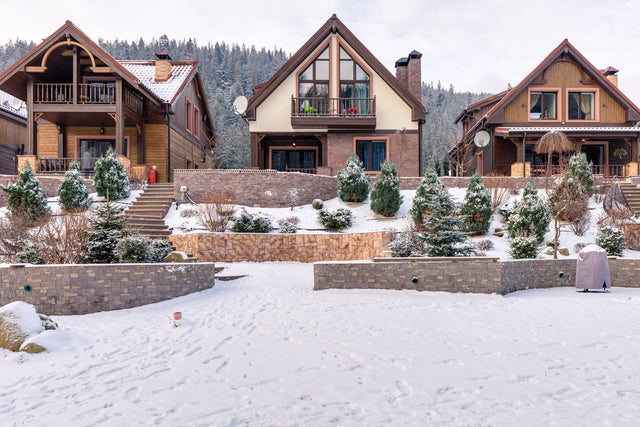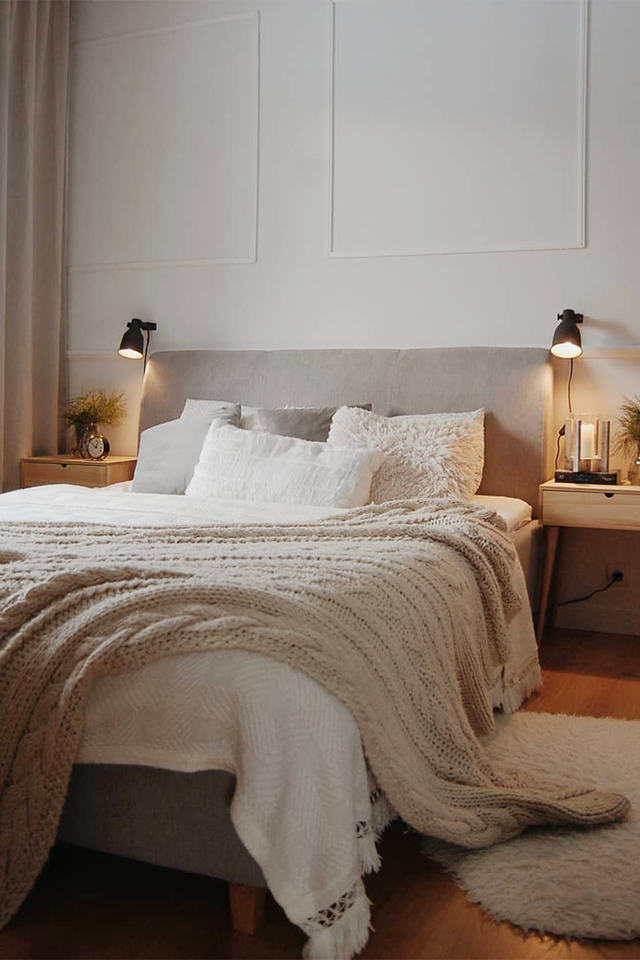Painting walls - a comprehensive guide
Want to freshen up your interior? Painting your walls is one of the easiest and most effective ways to quickly transform your home. Whether you're planning a complete change of layout or just want to give your walls a fresh new look, the right paint and technique can work wonders. The best part? You can do it yourself and save money on professional costs!
However, please note that the key to a lasting and aesthetic effect lies in the proper preparation of the surface, protection of skirting boards and wall surfaces, as well as in well-selected tools and paints.

Types of paints – which one to choose?
The choice of paint has a huge impact on the final effect. There are different types on the market, each with its own unique properties:
-
Latex paints – resistant to abrasion and moisture, perfect for kitchens and bathrooms.
-
Acrylic paints – quick-drying and universal, ideal for most rooms.
-
Vinyl paints – provide a smooth finish, although they are less resistant to moisture.

Necessary tools
Don't forget about the right tools, which can make the job much easier and affect the quality of the finish. Prepare:
-
Paint rollers – ideal for large surfaces, provide even coverage.
-
Brushes – essential for precise finishes and hard-to-reach places.
-
Painter's tape – helps protect edges and avoid dirt.

Painting techniques – how to get the best effect?
The painting technique is of great importance for the final effect. To achieve even coverage and avoid streaks, it is worth considering:
-
Roller painting – quick and convenient, ideal for large surfaces.
-
Spray painting – provides a smooth finish but requires practice.
-
Wet on wet method – allows you to avoid visible joints between layers.
Preparing walls for painting
Solid wall preparation is the foundation for a durable and aesthetic painting effect. The process involves three key stages:
-
Cleaning – removing dust, dirt and remnants of old paint.
-
Repair – filling gaps and smoothing the surface.
-
Priming – improving paint adhesion and reducing paint consumption.
The optimum temperature is between 10-30ºC and humidity should not exceed 80% . Then applying paint will be one of the most enjoyable painting jobs.
Don't forget to prepare the interior itself! Remove or secure furniture, cover floors and windows with foil, and tape the edges of walls with masking tape.

Priming walls – when and why is it necessary?
Priming is a step that should not be skipped! It is crucial for paint adhesion and even coverage. It is especially important in the case of:
-
highly absorbent walls,
-
previously painted surfaces,
-
new plasters, which may absorb paint unevenly.
A proper primer not only increases the durability of the coating, but also reduces paint consumption - which means saving material and a better final effect. Skipping this step can result in uneven coverage and the need for additional coats.
It is also worth following modern technologies in the painting industry. Innovative paints and primers can significantly facilitate the process of preparing walls, shortening the work time and improving the quality of the finish.

How to choose the right wall paint?
Choosing a paint for your walls is not only a matter of aesthetics, but also durability and functionality. There are different types of paints available on the market, such as latex, acrylic and vinyl . Each of them has unique properties, so it is worth matching them to the specifics of the room and the expected effect.
Here are the key features of each type of paint:
-
Latex paints – moisture-resistant and easy to clean, ideal for kitchens and bathrooms.
-
Acrylic paints – dry quickly, adhere well to the substrate and work well in places with high traffic, have very good coverage
-
Vinyl paints – provide a smooth, elegant finish, but are less resistant to abrasion, so they are best for bedrooms and offices, but you have to reckon with the higher costs of purchasing them
When choosing paint, it is worth considering not only its type, but also the conditions in which it will be used. A well-chosen paint can significantly affect the appearance and durability of the walls.

Types of paints and their uses
|
Type of paint |
Main Features |
Best use |
|---|---|---|
|
Latex paints |
Resistant to abrasion and moisture, easy to clean |
Kitchens, bathrooms, hallways, children's rooms |
|
Acrylic paints |
They dry quickly, adhere well to the substrate, and do not fade. |
Living rooms, bedrooms, frequently used spaces |
|
Vinyl paints |
Easy to apply, provides a smooth finish |
Bedrooms, offices, living rooms |
Choosing the right type of paint is key to a long-lasting and aesthetic effect. Before you start choosing the right paint, it is worth considering what features are most important to you - resistance, ease of application or visual effect.
Wall painting tools
Choosing the right painting tools is key to achieving an aesthetic and lasting effect. Regardless of whether you just want to refresh the color in your living room or completely change the look of the interior, properly selected accessories will make the work easier and allow you to avoid streaks and unevenness.
Basic tools to have on hand:
|
Tool |
Application |
|---|---|
|
Paint rollers |
Perfect for covering large surfaces |
|
Brushes |
Indispensable for precise painting of corners and details. |
|
Cuvettes |
They help to apply the paint evenly |
|
Painter's tapes |
They protect surfaces from dirt and allow you to obtain even edges. |
It is worth remembering that:
-
Short-bristled rollers work best on smooth walls, ensuring even coverage.
-
Rollers with longer bristles are more effective on rough surfaces.
The right choice of tools not only speeds up the work, but also allows you to achieve a result worthy of a professional.

Room Painting Techniques
Painting walls is not only about choosing a color, but also the right technique that affects the final effect. You can choose a classic, uniform finish or decorative patterns that will give the interior a unique character. It is worth learning the most popular wall painting techniques to match them to your expectations and skills.
The most commonly used methods are:
-
Roller painting – quick and even coverage of large surfaces.
-
Spray painting – precise and uniform finish, requiring specialist equipment.
-
Wet on wet technique – smooth connection of paint layers, eliminating streaks.
-
Painting in a V-shape – a way to achieve decorative effects and even paint distribution.
Each of these methods has its advantages and requires a different approach. Choosing the right technique can significantly affect the final result, so it's worth taking a moment to familiarize yourself with their specifics.
Painting walls with a roller – how to get even coverage?
Painting with a roller is one of the simplest and most frequently chosen methods. It allows for quick and effective wall covering, and with the right technique, you can avoid streaks and unevenness.
For best results:
-
Use a V-shaped painting method to distribute the paint evenly.
-
Make long, smooth movements, being careful not to press the roller too hard against the wall.
-
Before starting work, clean the roller of dust and loose fibers to avoid unsightly marks.
This technique is suitable for both beginners and more experienced painters.
Painting in a V-shape – a technique for better results
V-painting is a technique that helps to achieve even coverage and avoid streaks. It involves applying paint with a V-shaped roller, which allows for better paint distribution and minimizes the risk of unevenness.

The cost of painting walls – what influences the price?
Planning to refresh your walls? Great idea! However, before you reach for the brush, it is worth analyzing the costs of the entire undertaking . The price of painting is not fixed - it depends on many factors that can significantly affect your budget. Knowing them in advance will help you avoid unpleasant surprises.
The most important factors influencing the cost of painting are:
-
The surface of the walls – the larger it is, the more paint and time is needed, which naturally increases the costs.
-
Type of paint – premium paints, such as moisture-resistant or stain-resistant, are more expensive but provide greater durability and aesthetics.
-
Preparatory work – cleaning the walls, filling in gaps or priming increases the cost, but improves the quality and durability of the painting.
How much does it all cost? Painting services start at a dozen or so zlotys per square meter , but the final amount depends on the specifics of the project. That's why it's worth analyzing all the factors carefully to make an informed decision.
The Most Common MISTAKES When Painting Walls and How to Avoid Them
Painting walls seems easy – all you need is a brush, a roller and a can of paint. However, in practice, it is easy to make mistakes that lead to streaks, unevenness or faster paint wear. Fortunately, by following a few rules, you can avoid these problems and achieve a result worthy of a professional.
1. Insufficient preparation of the substrate
The walls must be clean, dry and smooth . If you skip this step, the paint may peel or spread unevenly. Painting a wet surface leads to blisters that will eventually fall off. To avoid this:
-
Remove dust and dirt with a damp cloth.
-
Fill the gaps and level the surface.
-
Allow the wall to dry completely before painting.
2. Applying too thick a layer of paint
This is a mistake! Too thick a layer:
-
I dry longer,
-
creates streaks and unevenness,
-
may peel off.
3. Skipping priming
Priming is a key step that:
-
improves paint adhesion,
-
prevents stains,
-
reduces paint consumption, which saves time and money.
Do not skip this step if you want a lasting and aesthetic effect.
4. Ignoring the manufacturer's recommendations
Each paint has its own specific properties and application requirements. If you ignore them, you can end up with an unsightly finish and shorter durability of the coating. Therefore, always:
-
read the instructions on the packaging,
-
follow the recommendations regarding drying time,
-
use appropriate application tools.



















